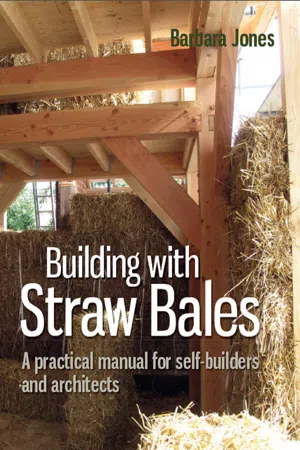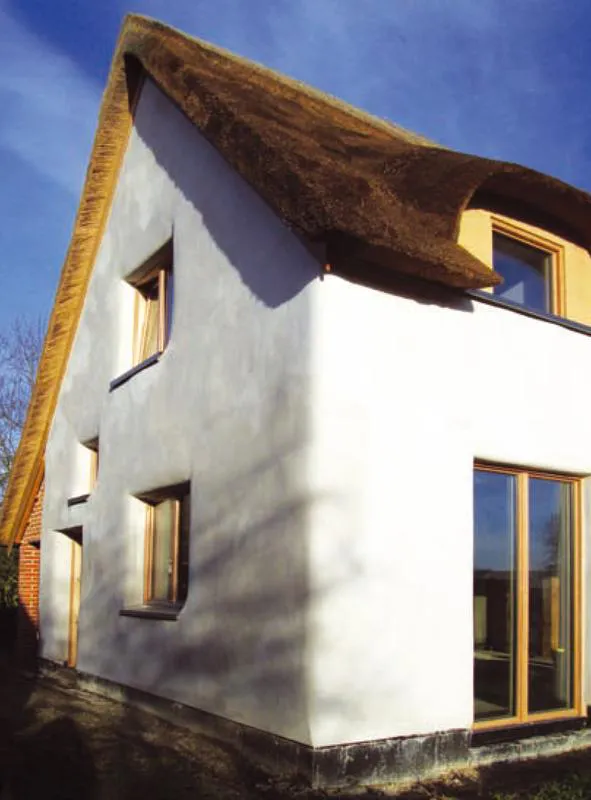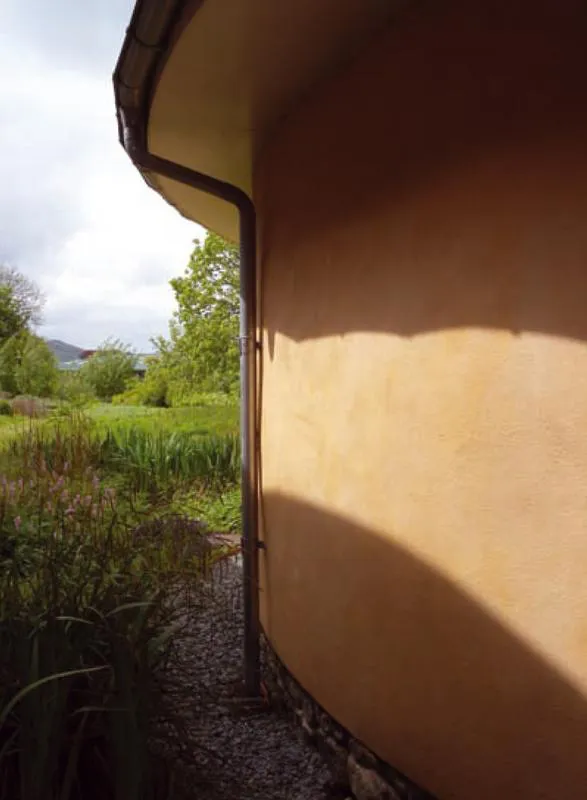CHAPTER 1
Why build with straw bales?
Building with straw makes so much sense! No other building material stores as much carbon within itself, or provides so much insulation for so little cost, or is as easy to build with. So why aren’t there more straw-bale houses? Partly, there is still lack of awareness about this humble building material. Partly, there is fear of something so simple and straightforward. Partly, it’s because of lack of affordable land available for people of limited means but with determination and ability. But mostly, there is no profit to be made in the usual way of a business selling a product, because straw-bale building is as much about passion, about empowerment, about belief – a way of life – as it is about construction.
Straw-bale building offers us a radical way to solve many of the issues facing construction with respect to thermal efficiency, carbon footprint production, sustainable materials, durability, air quality and cost. It’s far more than just a wall-building technique; it’s a completely different approach to the process of building itself. Its background is grass-roots self-build: it is firmly based in that sustainable ‘green building’ culture that has brought to the construction industry many new and useful ideas about energy efficiency and environmental responsibility.
This method of building is now entering mainstream construction via co-housing projects, designers and architects, and community groups, which see its value in terms of cost-effectiveness, sustainability, ease of installation, air-tightness and energy efficiency. The building method itself is based on a block system, making the designs very easy to adapt from one project to another, and giving great flexibility in its use.
The accessible nature of straw as a construction material means that even those unfamiliar with this building process can participate in it. This opens the door for interest groups to work together on joint projects. Housing associations, co-operatives, and local authorities are ideal managers for self-build straw projects, which are quick to build and which will engender an excitement and motivation that gets the job done.
The atmosphere on a straw-bale building site is qualitatively different from that found on the vast majority of other sites; it is woman-friendly, joyful, optimistic and highly motivated. Knowledge and skills are freely shared, and cooperation and teamwork predominate; all these factors have a positive effect on health and safety on site.
Working with straw is unlike working with any other material. It is simple, flexible, imprecise and organic. It will challenge your preconceptions about the nature of building and the correct way of doing things – and not everyone will be able to meet this challenge. The simplicity of straw can be disarming, or alarming. If you need complexity in order to feel secure, this may not be for you. Don’t be put off by nursery tales about the big bad wolf – we should be wise enough to realize that the wolf probably worked for the cement manufacturers! And there are thousands of examples of professionally finished buildings – so read on, and make up your own mind.
Straw as a building material excels in terms of its simple installation, affordability, energy efficiency, and the healthy air quality it produces. Straw-bale houses can be built to Passivhaus standards, and a two-bedroomed detached load-bearing straw house can be built by a self-builder for £50,000. Due to the buildings’ super-insulation, huge savings in heating costs can be made. Potential savings of up to 75 per cent on long-term running costs can be achieved when compared with a conventional modern house. A typical plastered straw wall has a U-value of 0.11, more than twice as insulating as Building Regulations require. And because straw houses can be built entirely of natural materials, there is no threat from toxic materials, and no harm to allergy sufferers.
This book is aimed at self-builders and architects as well as the construction industry. It is meant to give clear and straightforward information about how to build houses with bales of straw. Since this is a simple and accessible wall-building technique available to almost anyone, it is an ideal self-build manual; it also provides information for mainstream designers and builders to design with straw, and to write specifications for sustainable house building.
Throughout this book I will be attempting to encourage you towards the best possible way of doing things with a simple, straightforward and common-sense approach. One of the best features of straw-bale building is the opportunity it provides for creative fun, and the way it enables you to design and build the sort of shape and space you’d really like. It lends itself very well to curved and circular shapes, and can provide deep window seats, alcoves and niches due to the thickness of the bales. It is flexible, and combined with flexible foundations (not as unusual as you might think) provides excellent buildings to withstand earthquakes. Its forgiving nature means it can be knocked back into shape fairly easily during wall raising, doesn’t require absolute precision, and can make rounded as well as angular corners. Partly owing to its great insulation value and partly because of its organic nature, the inside of a straw-bale house feels very different from a brick or a stone one, with a cosy, warm quality to it and a pleasing look to the eye. The beauty of straw (apart from its aesthetic beauty) is that it combines very high insulation properties with great load-bearing ability: it is a material that provides building blocks and insulation all in one.
Different styles and opinions have grown up around the world as bale building has spread. What was suitable in one climate has not proved to be best practice in others, and availability and cost of materials varies from country to country. However, there have been wonderfully imaginative adaptations to conditions. Main design concerns are:
adequate foundations to deal with moisture and insulation while impacting on the earth as little as possible;
weather protection during construction;
weather protection in general.
By going back to basics, we are able to design more appropriate foundations than became common in the 20th century, which use natural rather than unnatural materials and achieve high levels of thermal efficiency. Differences to be found in the UK are also in the predominant use of load-bearing methods and the type of render (lime) used as a weatherproof coating. In Europe we have been able to draw on the rich knowledge of the past, using ideas that have been tried and tested over centuries. In many respects, the requirements of straw-bale buildings are essentially the same as those of traditional cob (earth) or wattle-and-daub buildings. They have high plinth walls, self-draining foundations and large overhangs to the roof – ‘a good hat and a good pair of boots’, as cob builders used to say. They are also constructed of breathable materials and must not be waterproofed (although they must be weatherproofed). Building with straw encompasses far more than a different wall-building system, however, as the whole building can be constructed of natural materials with very low embodied energy (the energy that was used in making the product) and a negative carbon footprint, all at an affordable price.
Straw is a flexible material and this requires us to work with it somewhat differently from the way we’d work if it were rigid. Accurate measurement and precision is impossible and unnecessary with straw, but working without these aids can be worrying to the novice, and alarming to those already used to building techniques developed in the last century. However, it is very important that you have the right attitude from the outset. You have to develop a feel for the straw. You have to give it time; absorb its flexibility. It is possible to be macho about it – to hurl bales around single-handedly and force them tightly into spaces – but this always has adverse consequences. Rushing the process, and working alone or competitively can mean that an adjoining section of wall is distorted and pushed out of shape – a section that someone else has spent time and care to get right. Straw-bale building is as much a personal learning process as it is about learning a new building technique. More than any other material (together with cob and clay), it is susceptible to your own spirit and that of the team. It is not something to do alone. It requires cooperation, skill-sharing and common sense. Many of the inspirational and artistic features are created in this atmosphere. It is empowering, expanding the world of opportunities ...









